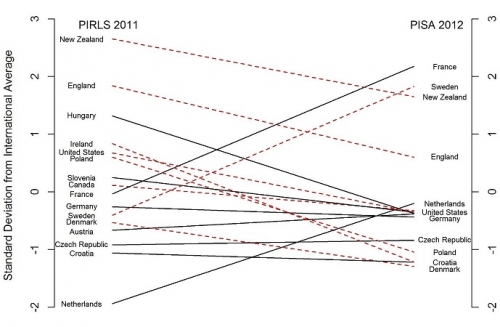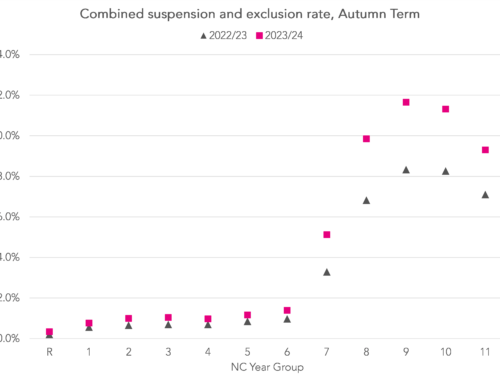The decision to allow a new grammar school to open in Kent drew a lot of media attention recently. With the exception of grammar schools, state schools in England are required to admit children irrespective of their ability.
A number of developed countries do have school systems, however, which select children into different-ability schools at an early age. For example, in Germany children are separated according to academic ability at 10 years of age while in the Netherlands children attend different schools based on their performance on a test at 12 years of age.
In this blog, we use international datasets to examine whether countries which select on ability have a greater degree of inequality in attainment.
Grammar schools in England
The main argument for having a selective education system is that pupils with higher ability will learn more if they go to schools with children of similar ability.
In response, critics argue that selective education systems tend to benefit children who come from relatively well-off backgrounds while, in contrast, comprehensive systems provide more opportunity to succeed for children who may not do well at an early age because of their family background.
In England researchers have attempted to use data from national assessments and more detailed longitudinal datasets to estimate the benefits that children get from attending a grammar school.
The results of these studies are inevitably controversial, however, because children who attend grammar schools are different in many ways from those who don’t, making it difficult to separate the effects of attending a grammar school from the effects of other characteristics which influence children’s outcomes.
Looking at the country-level picture
An alternative approach to studying the effect of selecting children into different-ability schools has been to use data from international large scale assessments such as PISA, TIMSS and PIRLS.
Country-level data allows a comparison of differences in pupil outcomes between countries which have different education systems and therefore avoids difficulties arising from the selection of pupils of different abilities into different types of school within each country.
In particular, one approach has been to look at the performance of students at ages both before and after selection, noting how this differs for countries which select pupils into different-ability schools and those with comprehensive systems.
In this study design, the early pupil outcomes are used as a control for country-level factors, such as economic prosperity, which also influence attainment.
This design was applied to data from children in grade 4 from the 2001 PIRLS survey and children age 15 years from the 2003 PISA study by Hanushek and Woessmann (2006).
Figure 1 below summarises their results on the change in inequality in attainment between primary and secondary school. It shows that in countries which selected pupils based on ability (those coloured black) inequality in attainment, measured relative to the mean level of inequality in attainment across countries, tended to increase between primary and secondary school. In countries with comprehensive school systems (red) inequalities conversely tended to fall over the same period.
Updating the evidence
We can repeat part of this study using more recent data from the 2011 PIRLS and the 2012 PISA surveys.
Figure 2 compares the standard deviation of children’s reading performance at age 8 (2011 PIRLS) and at age 15 years (2012 PISA) for a range of countries, with the red dashed lines identifying countries which use selection and the black solid lines countries which have comprehensive systems.
A degree of caution is needed in interpretation of the results because of the small number of countries used in the analysis.
The results suggest, however, that there is little overall difference in the change in the spread of test scores between selective and comprehensive systems between age eight and 15 years.
At a country-level, the most noteworthy difference from the results of the previous study is for Germany. In the previous study, Germany showed the largest increase in the spread in attainment with age, while in 2011/12 the relative variation in attainment in Germany is actually slightly lower at age 15 than at age eight.
The relative fall in the spread of attainment in Germany is interesting because in 2004/05 the country introduced a range of reforms to its education system.
These included a move towards a less hierarchical school system, the introduction of national standards and assessment, improved teacher quality and increased autonomy for school heads.
What conclusions can we draw?
Reform to the education system may well have been a factor in reducing the inequality in secondary-age attainment in Germany between 2001/2003 and 2011/2012.
It is difficult for researchers to draw strong conclusions about which factors are more or less significant in influencing change in education systems, however, because we have little understanding of how the behaviour of the system and the behaviour of the different parts are connected. In consequence, when we see change in education outcomes we usually have a list of potential causes but no real way of determining which are the more important.
If we want to understand how a selective education system might work without increasing educational inequalities, we need a greater understanding of how the different parts of education systems work together to influence overall levels of attainment.
Figure 1: Variation in test scores in PIRLS 2001 and PISA 2003 as a difference from the international average of national standard deviations (from Hanushek and Woessmann 2006)

Figure 2: Variation in test scores in PIRLS 2011 and PISA 2012 as a difference from the international average of national standard deviation







Leave A Comment